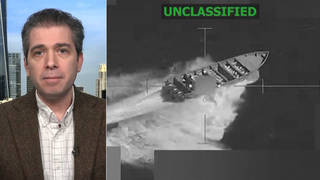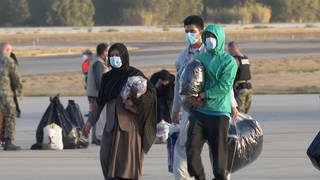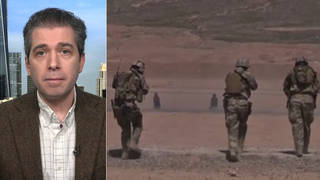
Topics
Guests
- Kristie Ebiprofessor of global health at the University of Washington in Seattle and the lead author of the 2018 National Climate Assessment chapter on the human health impacts of climate change.
The White House released an alarming climate change report on Black Friday, attempting to bury a 1,656-page government assessment that directly contradicts President Trump’s history of climate change denial. The damning report, known as the National Climate Assessment, says that the consequences of climate change will leave no part of the U.S. untouched and that the warming climate will increase wildfires, crumble infrastructure, worsen air quality, destroy crops and lead to more frequent disease outbreaks. It also finds that global warming could shrink the U.S. economy by as much as 10 percent by the end of the century. The findings are a sharp rebuke to the Trump administration’s insistence that environmental regulations hurt jobs and hinder economic growth. We speak with Kristie Ebi, a professor of global health at the University of Washington in Seattle and the lead author of the report’s chapter on the human health impacts of climate change.
More from this Interview
- Part 1: Trump Admin Tries to Bury 1,656-Page Climate Report Warning of Devastating Health Impacts of Warming
- Part 2: Bill McKibben: New Report Reconfirms Climate Change Is Shrinking Inhabitable Parts of the Planet
- Part 3: A Green New Deal: Bill McKibben Hails Alexandria Ocasio-Cortez’s Plan to Combat Climate Change
Transcript
AMY GOODMAN: This is Democracy Now! I’m Amy Goodman. We end today’s show with the alarming new climate change report that the White House tried to bury by releasing it on Black Friday, one of the slowest news days of the year. The 1,656-page government assessment directly contradicts President Trump’s history of climate change denial, warning human-driven climate change threatens human health, will continue to lead to more extreme weather conditions and could shrink the U.S. economy by as much as 10 percent by the end of the century. The findings are a sharp rebuke to the Trump administration’s insistence that environmental regulations hurt jobs and hinder economic growth.
The major new study, known as the National Climate Assessment, was mandated by Congress, is based on the work of 300 scientists and 13 federal agencies. The study says the consequences of climate change will leave no part of the U.S. untouched and that the warming climate will increase wildfires, crumble infrastructure, worsen air quality, destroy crops, lead to more frequent disease outbreaks. In Alaska, communities will be forced to relocate due to coastal flooding and erosion. In Puerto Rico and the Virgin Islands, saltwater will taint drinking water. Fire season may spread to the Southeast.
The report also puts a shocking price tag on climate change, projecting climate impacts of $141 billion from heat-related deaths, $118 billion from sea level rise and $32 billion from infrastructure damage by 2100.
Since taking office, President Donald Trump has slashed environmental regulations at home and undermined global climate change treaties abroad. Just two days before the new report was released, Trump tweeted, “Brutal and Extended Cold Blast could shatter ALL RECORDS–Whatever happened to Global Warming?” he tweeted.
Well, for more, we go to Seattle, Washington, where we’re joined by Kristie Ebi. She is a professor of global health at the University of Washington. She was the lead author of the chapter on the human health impacts of climate change in the new National Climate Assessment.
We welcome you to Democracy Now! Can you start off, Professor Ebi, by summarizing the findings, I mean, that the economy could shrink by 10 percent, the effects of climate change, and also what you found in your chapter on the kind of health effects climate change has? This is not talked about as much as other areas.
KRISTIE EBI: Well, thank you for your interest in the report. Really appreciate seeing the wide range of media coverage.
And the report does lay out quite clearly what we know about what’s already happening in the United States from a changing climate. And you noted there’s a range of changes already underway. We can see climate change happening now; it’s happening in people’s backyards. It’s affecting their health. It’s affecting their livelihoods.
And the projections suggest that if we continue on the path that we’re on in terms of emitting greenhouse gas emissions and not doing much about reducing those emissions and not doing much about trying to adapt to these changes, then the projections later in the century are quite significant.
For health, we’re looking at increases in heat-related mortality, more people being affected in extreme weather and climate events, vector-borne diseases changing their range, worsening air quality, effects on mental health. So there’s a wide range of possible adverse health consequences. And, of course, those consequences are unevenly distributed. As a previous speaker talked about, there’s deep inequities across the United States, and people living in certain locations and people with certain characteristics—people who are older, people who have got certain chronic medical conditions—will be more affected than some others.
So, we point out in the chapter both the breadth and depth of possible adverse health consequences of a changing climate, who might be most vulnerable to those. And then we go on and talk about the very large number of possibilities for reducing those risks—of improving, for example, heat wave early warning systems. No one needs to die in a heat wave; most of those deaths are preventable. So, if we really improve those heat wave early warning systems, then heat waves will continue, but people won’t have to die in them. And also reducing our greenhouse gas emissions will reduce temperature change later in the century.
And equally important from the perspective of the health sector is most mitigation policies have health benefits. The policies aren’t designed to benefit health, but they do benefit health. Reducing the amount of particulate emission out of our tailpipes, reducing particulate emission from coal-fired power plants benefits our health, and it benefits our health now. So when you calculate the costs that you save by not having people go to hospitals, by not having people die, the size of those benefits is about the size of the cost of mitigation. So we should be mitigating now for our health, because it will make us a healthier nation, and at the same time it will do good things for our livelihoods, for our ecosystems and for the planet.
AMY GOODMAN: Professor Ebi, how does this affect, oh, diseases like Lyme disease, dengue, Zika?
KRISTIE EBI: What we’re seeing is, for those kinds of diseases that are carried by mosquitoes or by ticks, is that as temperatures warm, the mosquitoes and ticks start changing their geographic range. There is well-documented evidence in Canada that Lyme disease is changing its range as temperatures go up. We’ve got strong suggestions, although we don’t have the surveillance in the U.S., that the mosquito that can carry dengue and can carry Zika also is changing its range. And the projections are that that will continue to happen, which means when diseases like Zika or dengue are introduced into the United States, we’ll not just see them perhaps in Florida and in Texas, but we’ll start seeing them in the Midwest, and eventually we could see them in a much broader range across the United States. And we do need to follow this, because we don’t want people to get sick and some people to die from these diseases.











Media Options